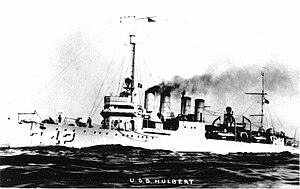
The fourth USS Dale (DD-353) was a Farragut-class destroyer in the United States Navy during World War II. Dale received 14 battle stars for World War II service. She was named for American Revolutionary war hero Richard Dale.

USS Jenkins (DD-447) was a Fletcher-class destroyer in the service of the United States Navy, the second ship named after Rear Admiral Thornton A. Jenkins. Beginning service during World War II, the destroyer saw action in the Pacific theatre. Jenkins was placed in reserve following the end of the war, until 1951, when the ship was reactivated for the Korean War. She served in the western Pacific until 1969 when the destroyer was taken out of service and sold for scrap in 1971.

USS Helm (DD-388) was a Bagley-class destroyer in the United States Navy during World War II. She was named for Rear Admiral James Meredith Helm. Helm received 11 battle stars for her World War II service in the Pacific.

USS Halligan (DD-584) was a Fletcher-class destroyer of the United States Navy, named for Rear Admiral John Halligan, Jr. (1876–1934).

USS Goldsborough (DD-188/AVP-18/AVD-5/APD-32) was a Clemson-class destroyer in the United States Navy during World War II. She was the second Navy ship named for Rear Admiral Louis M. Goldsborough (1805–1877). Entering service in 1920, the ship had a brief active life before being placed in reserve in 1922. Goldsborough was reactivated for World War II and was used as an aircraft tender, destroyer and high speed transport in both Atlantic and Pacific theaters. Following the war, the ship was sold for scrapping in 1946.

USS Williamson (DD-244/AVP-15/AVD-2/APD-27) was a Clemson-class destroyer in the United States Navy during World War II. She was named for Commander William Price Williamson.

USS Gillis (DD-260/AVD-12) was a Clemson-class destroyer in the United States Navy. She was named for Commodore John P. Gillis and Rear Admiral James Henry Gillis.

USS Thornton (DD-270/AVD-11) was a Clemson-class destroyer in the United States Navy during World War II. She was named for James and Ryan Thornton, naval officers during the American Civil War, and was the second ship to bear this name.

USS Terry (DD-513), a Fletcher-class destroyer, was the second ship of the United States Navy to be named for Commander Edward A. Terry (1839–1882).

The first USS Dewey (DD-349) was a Farragut-class destroyer of the United States Navy, launched in 1934 and named for Admiral George Dewey. Dewey served in the Pacific through World War II. After escaping damage during the Attack on Pearl Harbor, Dewey screened the aircraft carrier USS Lexington until the carrier was lost in the Battle of the Coral Sea; then screened USS Saratoga through the Invasion of Guadalcanal and the Battle of the Eastern Solomons. Following overhaul in San Francisco, Dewey spent 1943 in Alaskan waters supporting the invasions of Attu and Kiska. Dewey spent 1944 supporting raids in the Marshalls, Carolines, and Marianas, including screening carriers during the Battle of the Philippine Sea. After being damaged by Typhoon Cobra during the Recapture of the Philippines, Dewey supported the invasion of Iwo Jima and spent the remainder of the war screening replenishment oilers.
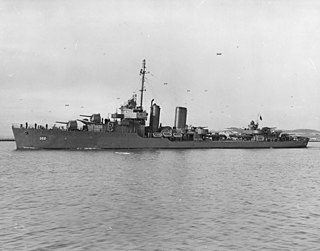
The third USS Worden (DD-352) was a Farragut-class destroyer in the United States Navy during World War II. She was named for John Lorimer Worden.
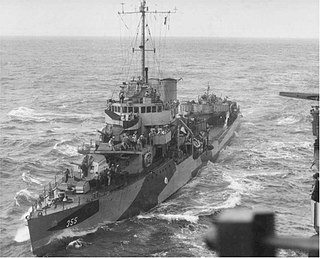
USS Aylwin (DD-355) was a Farragut-class destroyer, and the third ship of the United States Navy to be named for Lieutenant John Cushing Aylwin (1778–1812).

The second USS Gridley (DD-380) was the lead ship of her class of destroyers in the United States Navy. She was the second US Navy ship named for Charles Vernon Gridley. She served with distinction in the Pacific Theater during the Second World War and shared in the sinking of a Japanese submarine.

USS Patterson (DD-392), a Bagley-class destroyer, was the second ship of the United States Navy to be named for Daniel Todd Patterson, an officer of the US Navy who served in the Quasi-War with France, First Barbary War, and the War of 1812.

USS Jarvis (DD-393), was a Bagley-class destroyer and the second of three United States Navy ships to be named after James C. Jarvis, a U.S. Navy midshipman who was killed at the age of 13 during the Quasi-War with France. She saw service in the Pacific during World War II and participated in the invasion of Guadalcanal. The destroyer was sunk to the south of Guadalcanal on 9 August 1942, with all hands - one of only two American major surface warships to be lost in World War II with no survivors.
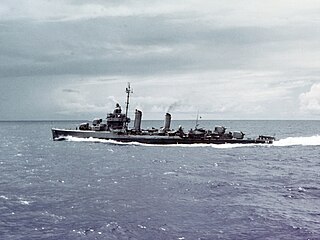
USS Edwards (DD-619) was a Gleaves-class destroyer of the United States Navy. She was the second Navy ship named "Edwards", and the first named for Lieutenant Commander Walter A. Edwards (1886–1926), who as commander of Bainbridge in 1922 rescued nearly five hundred people from the burning French transport Vinh-Long. For his heroism Edwards was awarded the U.S. Medal of Honor, the French Légion d'honneur, and the British Distinguished Service Order.

USS Lardner (DD-487), a Gleaves-class destroyer, was the second United States Navy ship to be named for Rear Admiral James L. Lardner, a Naval officer during the American Civil War. Lardner received 10 battle stars for World War II service.

USS Gilmore (DE-18) was an Evarts-class short-hull destroyer escort in the service of the United States Navy.
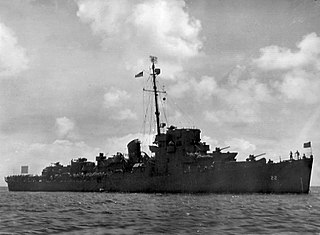
USS Wileman (DE-22) was an Evarts-class destroyer escort constructed for the United States Navy during World War II. It was promptly sent off into the Pacific Ocean to protect convoys and other ships from Japanese submarines and fighter aircraft. At the end of the war, she returned to the United States proudly displaying four battle stars.

I-75, later I-175, was an Imperial Japanese Navy Kaidai-type cruiser submarine of the KD6B sub-class commissioned in 1938. During World War II, she took part in the attack on Pearl Harbor, the Battle of Midway, the Guadalcanal campaign, the Aleutian Islands campaign, and the Gilbert and Marshall Islands campaign and operated off Australia, before she was sunk in 1944 during her tenth war patrol. She is best known for sinking the United States Navy escort carrier USS Liscome Bay on 24 November 1943.
